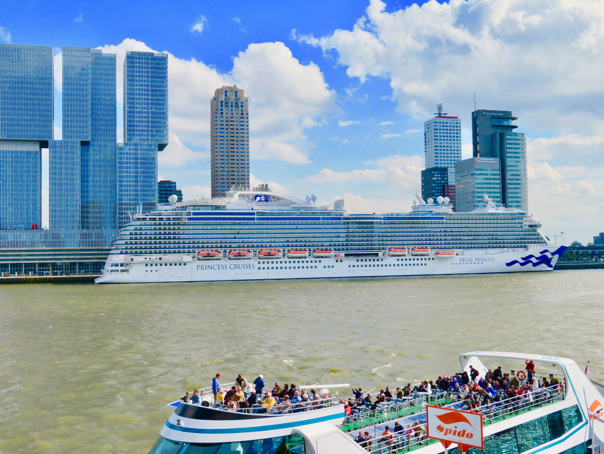Crossing the Atlantic

Crossing the Atlantic.
Well, nowadays it is a simple matter to cross the Atlantic in comfort high up in the air in one of the many transatlantic flights available. We, as well of thousand others, do this regularly as we go and visit Europe. But you do miss the charm of sea travel and the opportunity to relive the joys of another Titanic (oops). Well, we did travel by sea in both directions in our life.
a: Journey to the West.
The last time we crossed the pond was in 1962. We were leaving the Netherlands to enter the United States as new, legal immigrants. I had just earned my D.Sc. in chemical engineering from the Delft Technological University and I had several job interviews from prospective employers lined up in California. Even in 1962 it was not that straightforward to emigrate to the USA, if you were not white and were born outside of Europe. We were lucky, because we had received an immigration number under the Pastore-Walter Act. The population of the Netherlands was around 12-13 million at that time and the authorities felt that the country was getting too crowded. If you emigrate to the USA under this Act, the Dutch Government would finance the cost of the move.
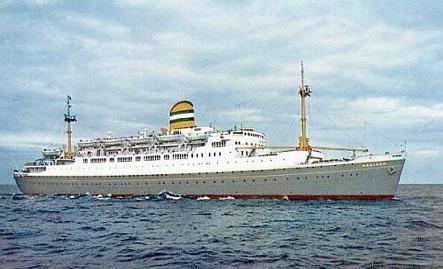
left: The m.v.Maasdam.
Our ship was the m.v. Maasdam, a small ship of the Holland America Line, launched on April 5,1952. At today’s standards it was a slow ship, sailing at just 16.5 knots; the journey from Rotterdam to New York took 8 days. We arrived in New York on Sunday, April 13, 1952.
At that time the design of the vessel was considered quite revolutionary. These ships were essentially built as Tourist class liners. The “Maasdam” was a twin of the “Rijndam”, built at about the same time with the same plans. Both these ships had the reputation of being “friendly” and many of the passengers were students, emigrants (just like us) and cultural groups. See ss.maritime.com/rijndam-maasdam.htm
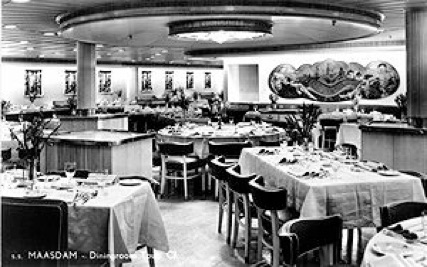
right: The dining room of the m.v. Maadam. This is pretty neat for that time.
The ship could accommodate 854 tourist and 39 first class passengers. Tourist passengers had the run of the ship, except for the top decks, where the elite could hold their noses high away from the hoy polloy in the nether regions of the vessel.
We had a small, dark, inside cabin on one of the lower decks. It was so small there was not enough space for two beds next to each other. So we had to sleep in a two-level bunk bed . There was a small washing basin in one corner. If you wanted to go to a toilet or take a shower, you had to go outside the cabin to the bathroom-shower complex. Well, it was free, courtesy of the Dutch Government.
A major problem with the ship was that it had still the freighter hull design, which meant that in rough weather, the ship would pitch and roll, causing a lot of discomfort for the passengers. The ship had a stabilizer, but it was new and not well tested, so this configuration actually made things worse.. I remember that the tables were anchored, so they would stay in place, but the chairs were not, so when we were playing bridge, we would have to grab the table to not slide away.
We also had to go through a hurricane, which relegated more than half the passengers to their beds because they were seasick and because it was impossible to walk on the decks without holding on to the railings. Weather forecasting was still in its infancy, so the ship could not adjust their route to reduce their exposure to bad weather. My wife spent many of the 8 sailing days in bed, because she was seasick most of the time.
b: Cruising Comfortably To the East.
It was April, 2019, and this time we were crossing the pond from West to East. We had a balcony cabin on deck of the Regal Princess, one of the larger vessels in the fleet of Princess. Our cabin on the Riviera deck also happened to be next to the Captains cabin, which was also adjacent to the bridge. There was, of course, a locked door on the hallway between our cabins. You don’t want to be able to disturb him when the weather is not to our liking.
The ship was substantially larger than the “Maasdam”; the “Regal Princess” can accommodate 3560 passengers, it has a crew of 1346, and was built in 2014; there are more than 1400 balcony cabins and the ship was obviously much more luxurious and upscale. Now we have a theater with a stage, a movie theater, an exercise room, several bars, several dining venues, shops, a casino, a special area for kids, a large choice of entertainment, which were not available six decades ago.
A picture of the “Regal Princess” is shown in the heading of this page.
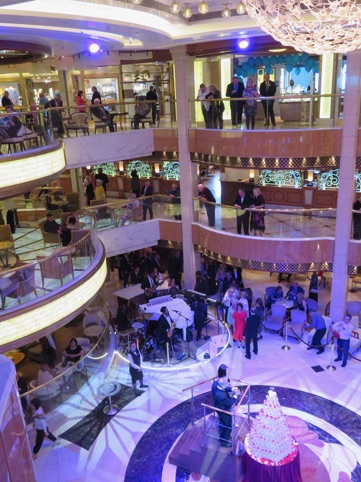
left: partial view of the atrium in the center of the vessel.
This was the champagne pouring party. Over the stack of champagne glasses of the bottom right of the picture, passengers were invited to pour champagne over the pyramid while their pictures are taken. Making and selling onboard pictures are large income generators for the ship.
It was a long 8-day journey on the “Maasdam”, a direct run from Rotterdam to New York. On the other hand, the 15 day cruise on the “Regal Princess” was very enjoyable. On this run we boarded the vessel in Fort Lauderdale and we disembarked in Copenhagen. In between there were several interesting ports of call. And modern technology has made the ship more stable, both in handling but also in the ability to adjust the itinerary to avoid areas of very rough weather.
But we still managed to get into a region where the winds were in the hurricane range; at about 10-11 on the Beaufort Scale. This happened after we left Porto Delgado on our way to Belgium. This is serious business. For about 1 1/2 days we had waves of 4-5 meters high and winds up to 50-55 knots. But the ship was still relatively stable. It was actually more stable than on the sleek, modern ferry, the mv Hrossey” we had to take from Scalloway to Glasgow a few years ago.
But still, some 30 % of the passengers stayed in bed during this period. But you have to remember that the passengers here are older and more frail than the youngsters on the “Maasdam”
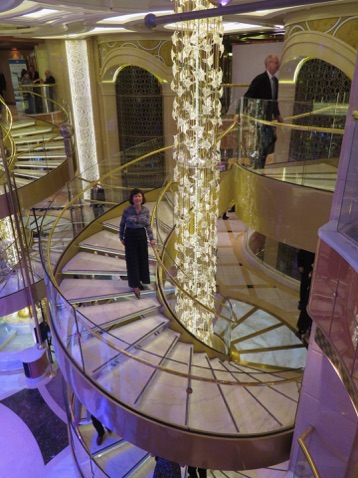
right: The spiral staircase descending into the atrium floor.
My wife, now not a youngster anymore, stayed in bed, because she was seasick. The crew members I talked to prescribed rest, no water, dry biscuits, green apples with honey, slices of fresh ginger in hot tea. The list would have been much longer, if I had spoken to more people. Every self-respecting mariner has his/her own recipe on how to combat seasickness.
I went to dinner by myself, and attendance was sparse; it seems many passengers had opted to stay in their cabins. My waiter suggested I order two helpings of lobsters, because there was too much food available.

left: It was Easter and the culinary crew had prepared these Easter eggs for display.
I never found out what they did with the eggs.


